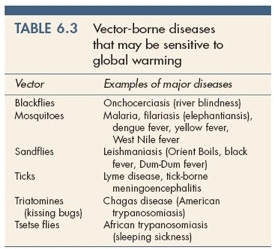Human Health: Rise in Temperatures Could Lead to Rise in Disease
| Topics: |
The fungal epidemic in amphibians demonstrates that global warming can be a major factor in the spread of pathogens. [1], [2] Of particular concern are human pathogens that spend part of their life cycle in host vectors (organisms that transmit diseases) that cannot regulate their temperature, such as bloodsucking insects.
Pathogenic viruses, bacteria, protozoans (single-celled, eukaryotic organisms), and worms need to complete certain life stages within the lifespan of their host vector, and warmer temperatures speed their development. On the host vector side, warmer temperatures not only extend the range of cold-sensitive bloodsucking insects, but also increase their egg production and thus the frequency of their blood feeds. All of these factors serve to expand the range and to accelerate the spread of epidemics.
Many cities were established at latitudes or altitudes that were previously too cold for such diseases to be endemic (common to the area). With global warming, minimum temperatures are increasing even faster than maximum temperatures. As a consequence, some of these locations are becoming more vulnerable to these diseases.
For example, dengue fever is considered the most important vector-borne viral disease in the world. [3] It is limited to tropical and subtropical regions because freezing temperatures kill overwintering larvae and eggs of the one species of mosquito (Aedes aegypti) that transmits it. Computer models of Ae. aegypti populations suggest that climate-induced variations in population size are highly correlated with the number of reported dengue cases. [4] Extrapolating such models to the warmer world of the future predicts that 50% to 60% of the human population will be at risk of dengue infection, versus 35% today. [5] For instance, towns such as Broome and Katherine, Australia will lie squarely in the endemic region where today they are generally dengue-free.
Malaria, perhaps the most debilitating disease of all, afflicts 350 million to 500 million people each year. The epidemiology of malaria is complex. Parasitic protozoans from four or five species in the genus Plasmodium cause this disease, and mosquitoes from 30 to 40 species in the genus Anopheles transmit it. Some studies predict that global warming could promote outbreaks at higher altitudes,[6] whereas others find no such trend. [7] [8] Indeed, factors such as greater pathogen resistance to antimalarial drugs and failed vector-control programs could be as important as global warming in affecting malaria incidence. [1] In fact, Hay et al found there to be no correlation between malaria incidence and twentieth century malaria incidence. [9]
If there is an increase in Earth temperatures, many regions will be able to enjoy outdoor environments more, so that crowded indoor virus spreading occasions are reduced, thus reducing spread of many viral diseases.
[1] Harvell, C. D., C. E. Mitchell, J. R. Ward, S. Altizer, A. P. Dobson, R. S. Ostfeld, and M. D. Samuel (2002) Ecology - Climate warming and disease risks for terrestrial and marine biota. Science 296:2158-2162.
[2] Patz, J. A., D. Campbell-Lendrum, T. Holloway, and J. A. Foley (2005) Impact of regional climate change on human health. Nature 438:310-317.
[3] World Health Organization (2002) Fact sheet: Dengue and dengue haemorrhagic fever. http://www.who.int/mediacentre/factsheets/fs117/en/index.html, accessed May 22, 2007.
[4] Hopp, M. J. and J. A. Foley (2003) Worldwide fluctuations in dengue fever cases related to climate variability. Climate Research 25:85-94.
[5] Hales, S., N. de Wet, J. Maindonald, and A. Woodward (2002) Potential effect of population and climate changes on global distribution of dengue fever: an empirical model. Lancet 360:830-834.
[6] Tanser, F. C., B. Sharp, and D. le Sueur (2003) Potential effect of climate change on malaria transmission in Africa. Lancet 362:1792-1798.
[7] Small, J., S. J. Goetz, and S. I. Hay (2003) Climatic suitability for malaria transmission in Africa, 1911-1995. Proceedings of the National Academy of Sciences of the United States of America 100:15341-15345.
[8] Reiter, P., C. J. Thomas, P. M. Atkinson, S. I. Hay, S. E. Randolph, D. J. Rogers, G. D. Shanks, R. W. Snow, and A. Spielman (2004) Global warming and malaria: a call for accuracy. Lancet Infectious Diseases 4:323-324.
[9] S.I. Hay, J. Cox, D.J. Rogers, S.E. Randolph, D.I. Stern, G.D. Shanks, M.F. Myers, R.W. Snow, "Climate change and the resurgence of malaria in the East African highlands", Nature 21 (2002): 415(6874): p.905-9.
This is an excerpt from the book Global Climate Change: Convergence of Disciplines by Dr. Arnold J. Bloom and taken from UCVerse of the University of California.
©2010 Sinauer Associates and UC Regents
